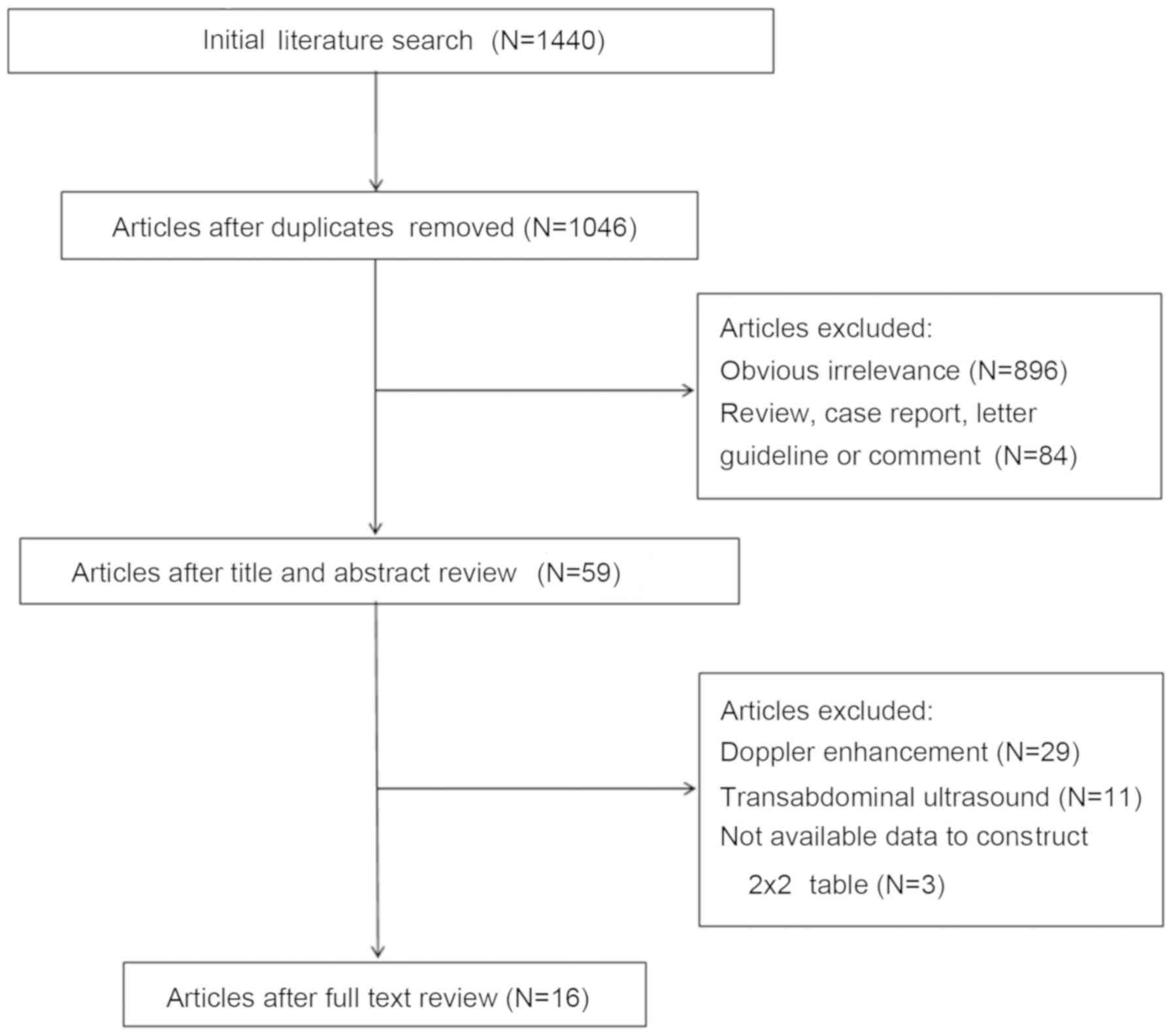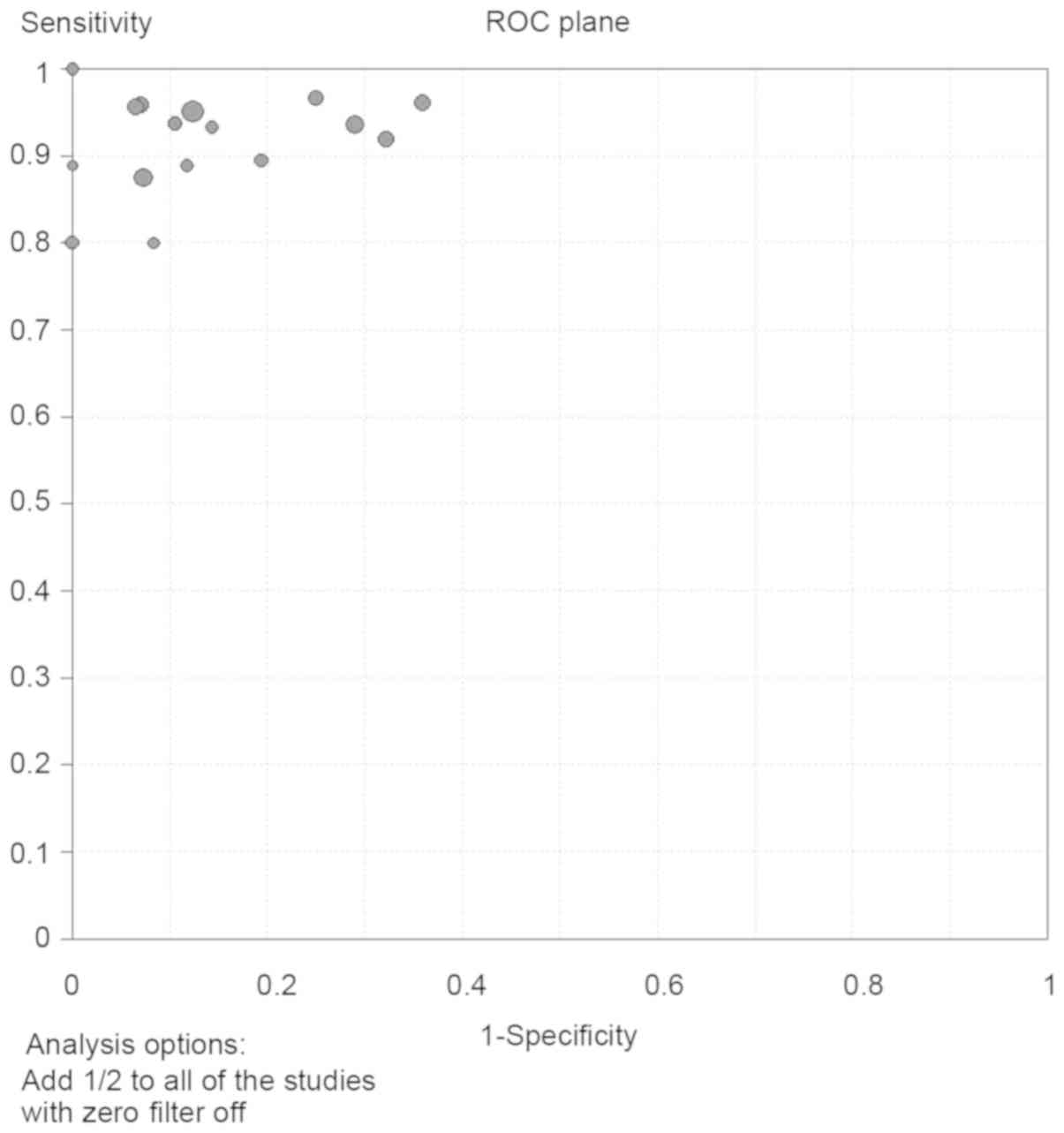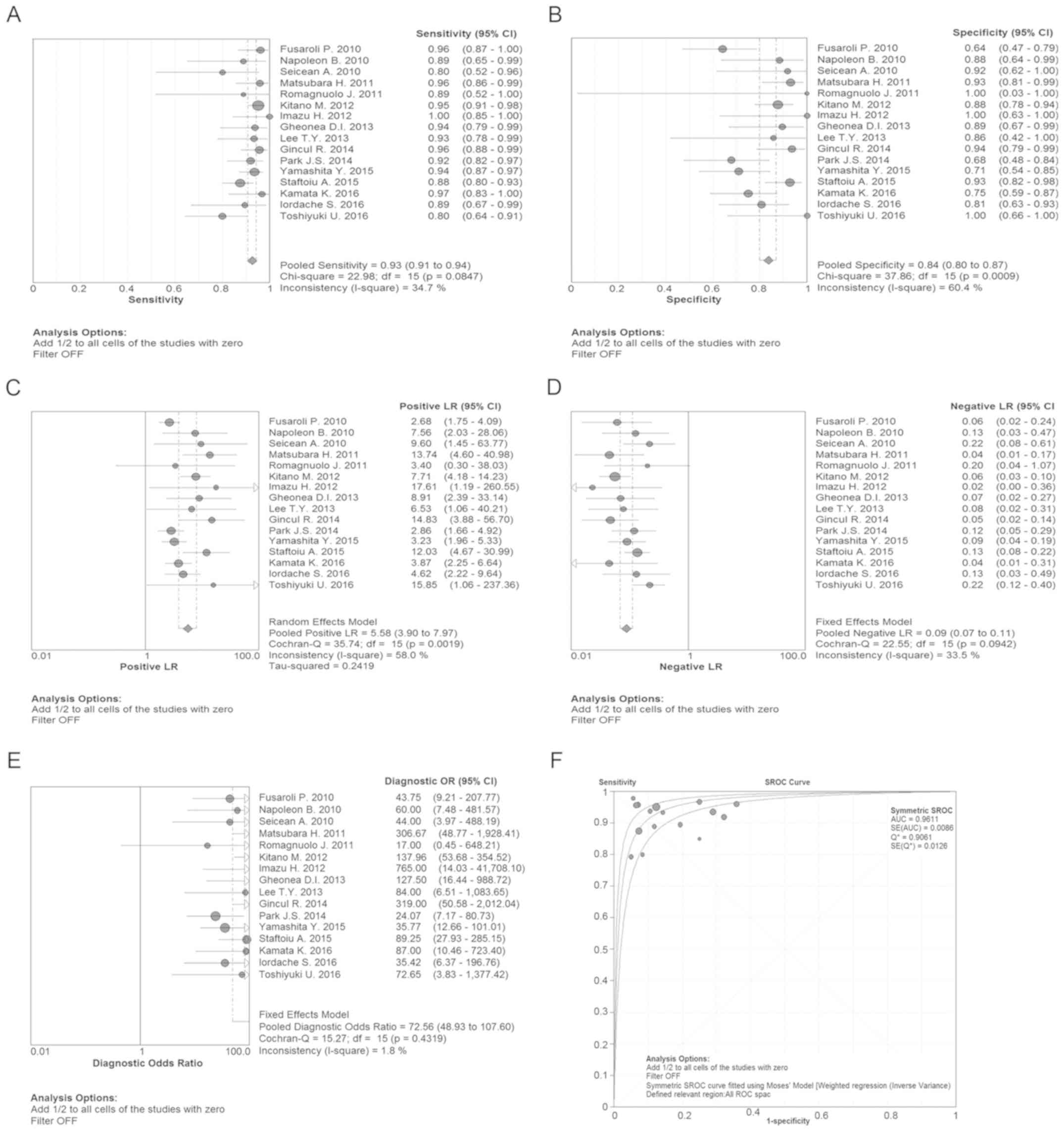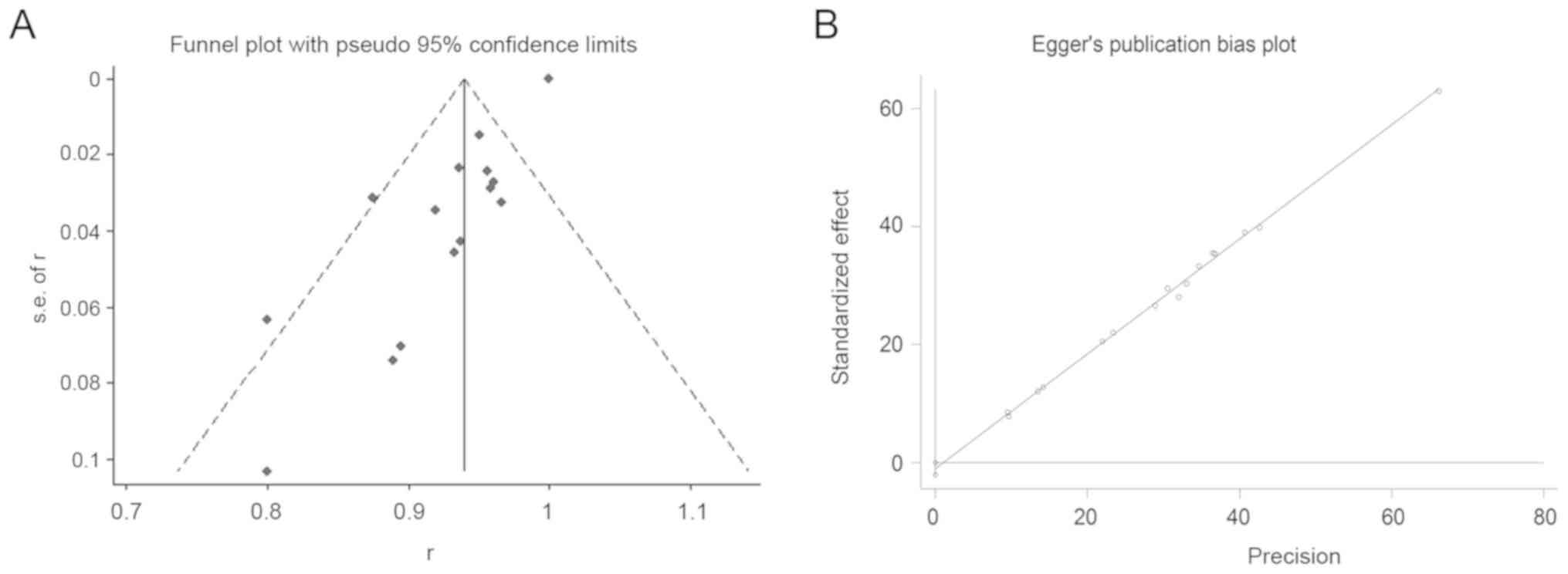|
1
|
Torre LA, Bray F, Siegel RL, Ferlay J,
Lortet-Tieulent J and Jemal A: Global cancer statistics, 2012. CA
Cancer J Clin. 65:87–108. 2015. View Article : Google Scholar : PubMed/NCBI
|
|
2
|
Hackeng WM, Hruban RH, Offerhaus GJ and
Brosens LA: Surgical and molecular pathology of pancreatic
neoplasms. Diagn Pathol. 11:472016. View Article : Google Scholar : PubMed/NCBI
|
|
3
|
Fusaroli P, Spada A, Mancino MG and
Caletti G: Contrast harmonic echo-endoscopic ultrasound improves
accuracy in diagnosis of solid pancreatic masses. Clin
Gastroenterol Hepatol. 8:629–634.e1-e2. 2010. View Article : Google Scholar : PubMed/NCBI
|
|
4
|
Gincul R, Palazzo M, Pujol B, Tubach F,
Palazzo L, Lefort C, Fumex F, Lombard A, Ribeiro D, Fabre M, et al:
Contrast-harmonic endoscopic ultrasound for the diagnosis of
pancreatic adenocarcinoma: A prospective multicenter trial.
Endoscopy. 46:373–379. 2014. View Article : Google Scholar : PubMed/NCBI
|
|
5
|
Whiting PF, Rutjes AW, Westwood ME,
Mallett S, Deeks JJ, Reitsma JB, Leeflang MM, Sterne JA and Bossuyt
PM; QUADAS-2 Group, : QUADAS-2: A revised tool for the quality
assessment of diagnostic accuracy studies. Ann Intern Med.
155:529–536. 2011. View Article : Google Scholar : PubMed/NCBI
|
|
6
|
Napoleon B, Alvarez-Sanchez MV, Gincoul R,
Pujol B, Lefort C, Lepilliez V, Labadie M, Souquet JC, Queneau PE,
Scoazec JY, et al: Contrast-enhanced harmonic endoscopic ultrasound
in solid lesions of the pancreas: Results of a pilot study.
Endoscopy. 42:564–570. 2010. View Article : Google Scholar : PubMed/NCBI
|
|
7
|
Seicean A, Badea R, Stan-Iuga R, Mocan T,
Gulei I and Pascu O: Quantitative contrast-enhanced harmonic
endoscopic ultrasonography for the discrimination of solid
pancreatic masses. Ultraschall Med. 31:571–576. 2010. View Article : Google Scholar : PubMed/NCBI
|
|
8
|
Matsubara H, Itoh A, Kawashima H, Kasugai
T, Ohno E, Ishikawa T, Itoh Y, Nakamura Y, Hiramatsu T, Nakamura M,
et al: Dynamic quantitative evaluation of contrast-enhanced
endoscopic ultrasonography in the diagnosis of pancreatic diseases.
Pancreas. 40:1073–1079. 2011. View Article : Google Scholar : PubMed/NCBI
|
|
9
|
Romagnuolo J, Hoffman B, Vela S, Hawes R
and Vignesh S: Accuracy of contrast-enhanced harmonic EUS with a
second- generation perflutren lipid microsphere contrast agent
(with video). Gastrointest Endosc. 73:52–63. 2011. View Article : Google Scholar : PubMed/NCBI
|
|
10
|
Kitano M, Kudo M, Yamao K, Takagi T,
Sakamoto H, Komaki T, Kamata K, Imai H, Chiba Y, Okada M, et al:
Characterization of small solid tumors in the pancreas: The value
of contrast-enhanced harmonic endoscopic ultrasonography. Am J
Gastroenterol. 107:303–310. 2012. View Article : Google Scholar : PubMed/NCBI
|
|
11
|
Imazu H, Kanazawa K, Mori N, Ikeda K,
Kakutani H, Sumiyama K, Hino S, Ang TL, Omar S and Tajiri H: Novel
quantitative perfusion analysis with contrast-enhanced harmonic EUS
for differentiation of autoimmune pancreatitis from pancreatic
carcinoma. Scand J Gastroenterol. 47:853–860. 2012. View Article : Google Scholar : PubMed/NCBI
|
|
12
|
Gheonea DI, Streba CT, Ciurea T and
Săftoiu A: Quantitative low mechanical index contrast-enhanced
endoscopic ultrasound for the differential diagnosis of chronic
pseudotumoral pancreatitis and pancreatic cancer. BMC
Gastroenterol. 13:22013. View Article : Google Scholar : PubMed/NCBI
|
|
13
|
Lee TY, Cheon YK and Shim CS: Clinical
role of contrast- enhanced harmonic endoscopic ultrasound in
differentiating solid lesions of the pancreas: A single-center
experience in Korea. Gut Liver. 7:599–604. 2013. View Article : Google Scholar : PubMed/NCBI
|
|
14
|
Park JS, Kim HK, Bang BW, Kim SG, Jeong S
and Lee DH: Effectiveness of contrast-enhanced harmonic endoscopic
ultrasound for the evaluation of solid pancreatic masses. World J
Gastroenterol. 20:518–524. 2014. View Article : Google Scholar : PubMed/NCBI
|
|
15
|
Yamashita Y, Kato J, Ueda K, Nakamura Y,
Kawaji Y, Abe H, Nuta J, Tamura T, Itonaga M, Yoshida T, et al:
Contrast-enhanced endoscopic ultrasonography for pancreatic tumors.
Biomed Res Int 2015. 4917822015.
|
|
16
|
Săftoiu A, Vilmann P, Dietrich CF,
Iglesias-Garcia J, Hocke M, Seicean A, Ignee A, Hassan H, Streba
CT, Ioncică AM, et al: Quantitative contrast-enhanced harmonic EUS
in differential diagnosis of focal pancreatic masses (with videos).
Gastrointest Endosc. 82:59–69. 2015. View Article : Google Scholar : PubMed/NCBI
|
|
17
|
Kamata K, Kitano M, Omoto S, Kadosaka K,
Miyata T, Yamao K, Imai H, Sakamoto H, Harwani Y, Chikugo T, et al:
Contrast-enhanced harmonic endoscopic ultrasonography for
differential diagnosis of pancreatic cysts. Endoscopy. 48:35–41.
2016.PubMed/NCBI
|
|
18
|
Iordache S, Costache MI, Popescu CF,
Streba CT, Cazacu S and Săftoiu A: Clinical impact of EUS
elastography followed by contrast-enhanced EUS in patients with
focal pancreatic masses and negative EUS-guided FNA. Med Ultrason.
18:18–24. 2016. View Article : Google Scholar : PubMed/NCBI
|
|
19
|
Uekitani T, Kaino S, Harima H, Suenaga S,
Sen-Yo M and Sakaida I: Efficacy of contrast-enhanced harmonic
endoscopic ultrasonography in the diagnosis of pancreatic ductal
carcinoma. Saudi J Gastroenterol. 22:198–202. 2016. View Article : Google Scholar : PubMed/NCBI
|
|
20
|
Krishna SG and Lee JH: Endosonography in
solid and cystic pancreatic tumors. J Interv Gastroenterol.
1:193–201. 2011. View Article : Google Scholar : PubMed/NCBI
|
|
21
|
Kim J: Endoscopic ultrasound-guided
treatment of pancreatic cystic and solid masses. Clin Endosc.
48:308–311. 2015. View Article : Google Scholar : PubMed/NCBI
|
|
22
|
Eloubeidi MA, Jhala D, Chhieng DC, Chen
VK, Eltoum I, Vickers S, Mel Wilcox C and Jhala N: Yield of
endoscopic ultrasound-guided fine-needle aspiration biopsy in
patients with suspected pancreatic carcinoma. Cancer. 99:285–292.
2003. View Article : Google Scholar : PubMed/NCBI
|
|
23
|
Sakamoto H, Kitano M, Suetomi Y, Maekawa
K, Takeyama Y and Kudo M: Utility of contrast-enhanced endoscopic
ultrasonography for diagnosis of small pancreatic carcinomas.
Ultrasound Med Biol. 34:525–532. 2008. View Article : Google Scholar : PubMed/NCBI
|
|
24
|
Dietrich CF, Ignee A and Frey H:
Contrast-enhanced endoscopic ultrasound with low mechanical index:
A new technique. Z Gastroenterol. 43:1219–1223. 2005. View Article : Google Scholar : PubMed/NCBI
|
|
25
|
Wu RI, Yoon WJ, Brugge WR, Mino-Kenudson M
and Pitman MB: Endoscopic ultrasound-guided fine needle aspiration
(EUS-FNA) contributes to a triple-negative test in preoperative
screening of pancreatic cysts. Cancer Cytopathol. 122:412–419.
2014. View Article : Google Scholar : PubMed/NCBI
|
|
26
|
Wang Y, Yan K, Fan Z, Sun L, Wu W and Yang
W: Contrast- enhanced ultrasonography of pancreatic carcinoma:
Correlation with pathologic findings. Ultrasound Med Biol.
42:891–898. 2016. View Article : Google Scholar : PubMed/NCBI
|













